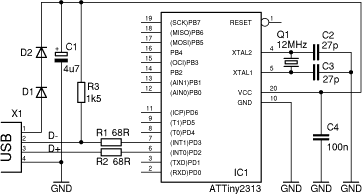I did want to give a little background on why someone would want a bit-banged USB implementation on a microcontroller. Today USB is the most ubiquitous interface available in the market. The connector was largely driven by the consumer space but has started to adapt quite well to markets I am more familiar with, medical and industrial. Although USB is widely used, it is not the easiest thing to understand. There are numerous profiles that have to be coded in software and different configurations that have to be accounted for in hardware.
Traditionally if a user wants to a add a USB connection they either have to get a processor with a USB controller or they have to insert a USB to UART bridge chip in between their microcontroller and the USB port. There are numerous suppliers with USB to UART bridge chips and the most popular is probably FTDI.
There are numerous open source projects that I am aware of that are starting to implement the bit-banged USB implementation without a bridge chip in between. A very popular implementation is the one for the AVR micros called V-USB - link.
Here is the schematic required to add a USB connection for the V-USB implementation, pretty simple:


No comments:
Post a Comment